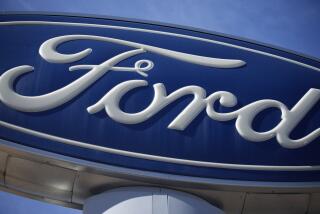Rivals Say Ford’s SUV Fuel Plan Is Hot Air
- Share via
Ford Motor Co.’s plan to increase its fuel-hungry SUV fleet’s average gas mileage 25% over the next five years is laudable but hardly revolutionary.
The world’s second-biggest auto maker gets points for being smart enough to make public relations hay with its announcement this week. But the truth is that most manufacturers’ sport-utility vehicles, on average, will be getting more fuel-efficient.
The reasons include advanced engine technologies, the scramble to satisfy consumers’ newfound interest in smaller, car-based SUVs and political pressure to improve truck fuel economy.
Federal fuel economy policies don’t measure SUVs separately; they are part of a larger light-truck classification that also includes pickups and minivans weighing under 8,500 pounds.
And Ford trails most of the pack in overall light-truck fuel economy this year.
So the kudos the car maker has garnered with its SUV promise is galling to some competitors.
“SUVs are about 30% of the truck fleet, so a 25% improvement means they’d get to 21.7 miles per gallon” if fuel consumption for Ford’s pickups and minivans stays the same, said Michael Love, national regulatory affairs manager for Torrance-based Toyota Motor Sales USA.
“That’s a significant gain, but our projected light-truck [fuel efficiency] for 2000 is 21.7 mpg, so we are there already.”
And Toyota’s truck mileage averages should improve a bit next year with the introduction of the Highlander, one of the new crop of so-called crossover, or car-based SUVs, that will be hitting the market over the next half-decade.
Vehicles such as the Highlander, which uses front-wheel drive and relatively lightweight unibody construction, typically get much better fuel economy than heavyweight SUVs built on truck frames.
Ford’s new Escape crossover SUV, for example, is rated as high as 28 mpg, versus 23 mpg for the most miserly of the company’s best-selling Explorer SUV models.
DaimlerChrysler Corp. says its truck fleet average jumped 2% this year just from the introduction of the hot-selling PT Cruiser. Although built on the Neon economy-car platform and using the Neon engine, the uniquely styled vehicle has a flat floor, which allows it to be classified as a truck for fuel economy purposes.
“We are moving in the same direction” as Ford, said DaimlerChrysler spokesman Mike Aberlich.
General Motors Corp., which boosted its truck fleet fuel economy by a hefty 5% this year with little public notice, cites refinements in its engine and powertrain design for most of the gain. The increase pushed it ahead of Ford by 0.2 mpg.
Next year’s totals should be even better, said GM truck division spokesman Joe Jaccuzi. The company is introducing a fuel-efficient in-line six-cylinder engine for its medium-sized SUVs, such as the Chevrolet Trail Blazer (formerly the Blazer).
It also is introducing two minivan-based “sport-activity” vehicles, the Pontiac Aztek and Buick Rendezvous, that should improve fleet averages. The Aztek, for example, is rated at 26 mpg on the highway and 19 mpg around town.
What Ford says it will do is being done, to some extent, by almost all truck and SUV makers, said Thad Malesh, director of North American automotive forecasting for J.D. Power & Associates, the Agoura Hills-based market consulting firm.
Power’s exhaustive buyer and manufacturer surveys, said Malesh, lead him to believe that “mileage in the whole SUV fleet will be improving in the long run. Most of the new vehicles are crossovers that, while classified as trucks, are really station wagons on steroids. They get better mileage because they are lighter.”
Still, Ford says that only about a third of its promised SUV fuel gains will come from the introduction of vehicles such as the Escape.
The rest will come the old-fashioned way: from small but continuing improvements in engine and fuel-system design and tuning, from weight savings achieved through increased use of lightweight materials such as aluminum and plastics and from aerodynamic improvements achieved in the design studios.
And that has won praise from a usually hostile quarter.
“Ford’s goal is meaningful because it will result in real-world improvements in fuel economy and emissions and isn’t based on smoke and mirrors,” said Roland Hwang, Berkeley-based transportation programs director for the Union of Concerned Scientists.
“If you look at trends in fuel economy, we are down about 4% in the passenger fleet from 10 years ago, mostly because of the introduction of so many trucks and SUVs,” he said. “So more announcements like Ford’s are needed. What they are doing shows that the technology exists for fuel economy improvements in trucks and SUVs.”
(BEGIN TEXT OF INFOBOX / INFOGRAPHIC)
Guzzling Less
Estimates for the 2000 model year show gains by six of the 12 auto makers with trucks, minivans and SUVs in their fleets. New technology and a spate of small SUVs slated for introduction over the next few years should help improve fuel economy ratings for most light-truck makers and dim the SUV’s reputation as a gas guzzler.
*
Light-truck fuel economy by manufacturer
*--*
Avg. combined highway/city mpg % change* Manufacturer 1999 2000* ’99 to ’00 General Motors 20.0 21.0 +5.0 Honda 24.2 25.3 +4.5 DaimlerChrysler 20.7 21.2 +2.4 Ford/Mazda 20.4 20.8 +1.9 Nissan 21.1 21.4 +1.4 Volkswagen 19.1 19.2 +0.5 Fleet average 20.7 20.8 +0.5 Federal standard 20.7 20.7 0 Land Rover 17.0 17.0 0 Suzuki 24.3 23.8 --2.1 Kia 24.2 23.5 --2.9 Isuzu 21.5 20.8 --3.3 Mitsubishi 22.3 21.5 --3.6 Toyota 22.6 21.7 --4.0
*--*
* Estimates
Source: National Highway Traffic Safety Administration






